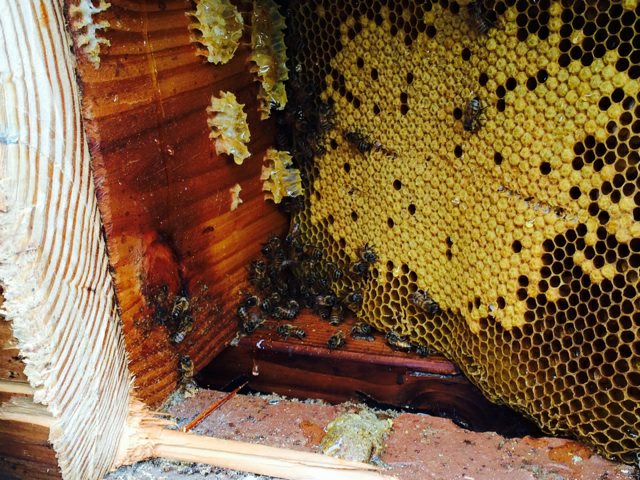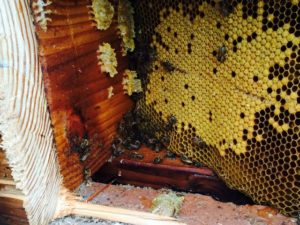Honey bees are a fascinating and often misunderstood insect, and ABC Wildlife is committed to educating people not only about the behavior and environmental benefits of this species, but also about what goes in to safely and effectively removing a colony from a structure. Honey bee removal is an intricate process, and we receive questions about it every day. Because we always want to give you the most thorough and accurate information, we sat down with Benjamin Rosenberger, one of our honey bee specialists, to answer some frequently asked honey bee removal questions.
What are the signs of a honey bee infestation?
Airport activity is the biggest thing. That’s essentially when there are two bees that have gone into an entrance and two bees that have come out of an entrance within a one second time-frame. We consider that to be extreme airport activity, and you’re going to see that on any day that is sunny and above 65 degrees. Some of the most common places to look for this are on chimneys, soffit areas, and anywhere there’s a transition from masonry to carpentry. Entrances are usually at least 8 feet off the ground.
Why do honey bees build their hives in houses?
Unfortunately, any average home is at risk. Homes are constructed in a way that they’re aesthetically pleasing, water tight, and structurally sound. But there are plenty of gaps in every home that honey bees can access to find a confined, voided space within the structure. Scouting bees will go out to look for an ideal hive location, and whichever one comes back and dances the hardest for the queen will determine the new hive site. So really, every home has potential.
Why is it best to use ABC Wildlife for honey bee removal rather than a standard beekeeper?
We have knowledge of the actual structure itself; how it’s constructed, where the voided spaces are going to be behind the siding, brickwork, or whatever exterior is on the home. We’ve done quite a few of these jobs and know the areas that bees get into. Rather than just cutting a random hole where someone may think there’s a hive behind a wall, we meticulously undo the layers of the home. And we do it in a way that most of the time, we are able to reuse the materials that were already there and not have anyone notice we were ever there. However, should something be damaged in the process, we know where to source the materials to replace it. A beekeeper is just a beekeeper. When you’re talking about opening up someone’s siding, he isn’t going to know what a home is constructed of, and he can’t just go to a big “box store” for those materials. We are extremely detailed in how we go about extracting a hive and repairing the structure.
Why do we have to remove the whole hive?
Everything has to be removed to prevent issues with other pests like bugs and rodents that are attracted to the wax and the honey. Also, there’s quite a bit of moisture in the honey, and since it is no longer being regulated in the comb by the bees, it will interact with any spores in the space and cause microbial growth. The areas that we open up to find bees are areas where there’s an exchange between the inside air and outside air, and that will always be a place where you find spores. So it’s important that all of the honey be removed from the cavity to avoid mildew and mold. We’ll scrape out the comb and all of the residue from where the bees attached the comb to the internal structural components of the voided space. We’ll also remove the propolis (a kind of botanical glue produced by the bees) from the gaps and the cracks between the structural members. And then once that’s done, we’ll insulate that voided space. Honey bees don’t have the mouthparts to be able to manipulate fiberglass insulation, so there won’t be a chance of them being able to come back and build in that spot. I’ve been to plenty of jobs where honey bees have been removed from the structure years ago, but because the beekeeper didn’t know to fill that voided space to prevent them from coming back, I’m now at their property removing this next hive.
What happens to a honey bee colony after we remove it?
Depending on how healthy the hive is, we try to reestablish them. It isn’t always possible since sometimes the honey bees have been misidentified as yellow jackets, and the homeowner, or someone the homeowner hired, has treated them with insecticide. But for the most part, we reestablish them in hives.
Is it illegal to kill honey bees?
No, it’s not illegal, but you really shouldn’t. It’s a bad thing to do, and it should be illegal, but as far as I know, there’s no law against it. Honey bees are excellent pollinators, and they do a lot of nature’s work for us when it comes to fruits and vegetables. In a hive, to be able to see so many individuals acting as one…it’s tremendously majestic. Honey bees understand that at different parts in their life cycle, they’re required to do different tasks, and they do it wholeheartedly. They manage to do this where humans can’t. They rely on each other to do their part to keep the colony thriving, and it creates a really healthy environment for the hive. Why would somebody want to kill something that is basically perfection?
How can people prevent a honey bee problem?
ABC Wildlife’s Preventative Maintenance Program is great for that. It leaves a good residual on the structure, so if a scout bee is poking around gaps and cracks, she will deem the structure uninhabitable. As soon as she lands on the house and tastes the treatment with her feet, she’s not going to want to be there. While our Preventative Maintenance Program is hugely beneficial, sealing all of those gaps around a home is definitely the best thing you can do, because it’s a physical barrier. However, one thing that should be noted is that there are gaps and cracks on houses that are intentional for ventilation and things of that nature. Those should never be sealed, and not knowing the difference between the two could create an issue for somebody. That’s why people should use a company like ours. We’re going to be able to recognize those special gaps and know whether or not they should be sealed.
If you hire a company like ABC Wildlife, honey bee removal doesn’t have to be a hassle. Like Benjamin said, we not only know how to remove the hive in a way that keeps the bees safe and ensures they won’t return, we also have an extensive knowledge of construction and home repair. ABC Wildlife will treat your property with the care and respect it deserves, restore it back to its original state, and offer you options to keep hives from forming in the future. Contact one of our honey bee removal experts today at (847) 870-7175.





